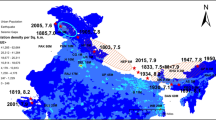Abstract
Predictive relations are developed for peak ground acceleration (PGA) from the engineering seismoscope (SRR) records of the 2001 Mw 7.7 Bhuj earthquake and 239 strong-motion records of 32 significant aftershocks of 3.1 ≤ Mw ≤ 5.6 at epicentral distances of 1 ≤ R ≤ 288 km. We have taken advantage of the recent increase in strong-motion data at close distances to derive new attenuation relation for peak horizontal acceleration in the Kachchh seismic zone, Gujarat. This new analysis uses the Joyner-Boore’s method for a magnitude-independent shape, based on geometrical spreading and anelastic attenuation, for the attenuation curve. The resulting attenuation equation is,
where, Y is peak horizontal acceleration in g, Mw is moment magnitude, rjb is the closest distance to the surface projection of the fault rupture in kilometers, and S is a variable taking the values of 0 and 1 according to the local site geology. S is 0 for a rock site, and, S is 1 for a soil site. The relation differs from previous work in the improved reliability of input parameters and large numbers of strong-motion PGA data recorded at short distances (0–50 km) from the source. The relation is in demonstrable agreement with the recorded strong-ground motion data from earthquakes of Mw 3.5, 4.1, 4.5, 5.6, and 7.7. There are insufficient data from the Kachchh region to adequately judge the relation for the magnitude range 5.7 ≤ Mw ≤ 7.7. But, our ground-motion prediction model shows a reasonable correlation with the PGA data of the 29 March, 1999 Chamoli main shock (Mw 6.5), validating our ground-motion attenuation model for an Mw6.5 event. However, our ground-motion prediction shows no correlation with the PGA data of the 10 December, 1967 Koyna main shock (Mw 6.3). Our ground-motion predictions show more scatter in estimated residual for the distance range (0–30 km), which could be due to the amplification/noise at near stations situated in the Kachchh sedimentary basin. We also noticed smaller residuals for the distance range (30–300 km), which could be due to less amplification/noise at sites distant from the Kachchh basin. However, the observed less residuals for the longer distance range (100–300 km) are less reliable due to the lack of available PGA values in the same distance range.
Similar content being viewed by others
Author information
Authors and Affiliations
Rights and permissions
About this article
Cite this article
Mandal, P., Kumar, N., Satyamurthy, C. et al. Ground-motion Attenuation Relation from Strong-motion Records of the 2001 Mw 7.7 Bhuj Earthquake Sequence (2001–2006), Gujarat, India. Pure appl. geophys. 166, 451–469 (2009). https://doi.org/10.1007/s00024-009-0444-y
Received:
Accepted:
Issue Date:
DOI: https://doi.org/10.1007/s00024-009-0444-y




